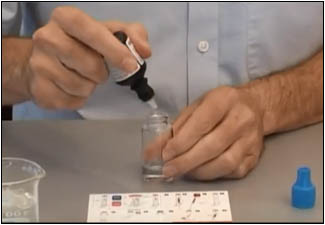 How to ACCURATELY Test Aquarium Water
How to ACCURATELY Test Aquarium Water
We also have a YouTube Video for this articleGood aquarists don’t maintain aquariums—they maintain water. And it is impossible to maintain your water without testing. Reference our
Aquarium Testing Recommendations Chart to see what parameters to test for and how often. When you test you want the most accurate and precise measurements you can get. Here are some tips to help you improve your precision and accuracy.
Precision
How consistent are your test results? When you test your pH three times, and each time the test measures 8.2, the test is very precise. If the test measures 8.1, then 8.3, and then 8.2 the test is not precise. Precision does not mean the results are correct, but that they are repeatable. Even if the actual pH of the water you tested was 6.5 and your result was consistently 8.2, your results would still be precise.
The key to getting precise results is performing your tests identically each and every time. Here are some simple steps to help you stay consistent.
1. Wash your test tubes with RO water
2. Follow the directions exactly. This means adhering to the exact recommended waiting time between steps.
3. Test in the same place and at the same time every time you test. This will result in precise results as lighting affects how your eye reads color-based tests, and some parameters change throughout the day.
4. Use
syringes to measure aquarium water rather than the lines printed on test cylinders. This will ensure you start with a more consistent amount of water for each test.
5. When adding drops, put the dropper at the same angle to the solution every time. This will ensure that each drop has the same volume of liquid every time.
Accuracy
Accuracy describes how close your results are to the actual value. If your pH test result is 8.2 and the pH value is actually 8.2, the results are accurate. If your average result is 8.2, even though none of the actual results are 8.2, the results are still accurate.
To make sure that your results are accurate there are a few steps you can take.
1. Remove the weakest link
A test is no more accurate than its least accurate factor, and usually, the least accurate factor is the human element. When you use your eye to read a color-based test or to read numbers on a scale, your eye is different from everyone else’s and this can be a cause of errors in the results. Using a
pH Test Kit, digital refractometer, and
digital colorimeter will remove the human error from your testing.
2. Use reference solutions
How do you know if your test kit is reporting correctly? Use a reference solution. A reference solution is a solution created in a lab that is certified to give a specific result. There are
pH solutions,
salinity solutions,
TDS solutions, and
natural seawater solutions. Using your test on the solution will let you know how close to the true value your test kit is reading. If you have electronic testers, you can adjust them to match the value the solution is reporting by calibrating your tester.
3. Use multiple methods
There are many things that can cause a test to be inaccurate. Stray voltage in your aquarium can cause your pH probe to read incorrectly. A dirty test vile can result in false readings with colorimetric pH tests. Because of this, it is often best to use two different technologies for testing. You could test with both a colorimetric test and digital meter, or using a
hydrometer and refractometer (or a
MarineAndReef.com Reefractometer).
4. Use testing services
There are services where you can have lab technicians test your water for you. With the
ICP Water Analysis Kit from
ICP-Analysis.com you can take a sample of your water and send it to the ICP Lab to be tested using inductively coupled plasma (
electronic plasma spectroscopy). The results are emailed to you. This is an excellent way to have professional test results on your tank and get insight into what could be causing a problem or limiting your tank’s potential.




























 How to ACCURATELY Test Aquarium Water
How to ACCURATELY Test Aquarium Water